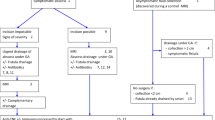Abstract
Condyloma acuminatum, in the form of genital warts, usually results from an infection by human papillomavirus, one of the most common causes of sexually transmitted diseases. It develops after an incubation period of 3 weeks to 8 months after infection; flat lesions are significantly rare. Condyloma acuminatum is prevalent in the genitals, particularly in the anus of immunodeficient patients. This also occurs in women during menstrual period and pregnancy. Although a common treatment option for rectal and anal lesions, surgical resection is highly invasive and results in a high rate of recurrence. Recently, endoscopic submucosal dissection has been performed for anorectal lesions, but data on its long-term follow-up are not available. We report the case of an immunocompromised patient due to pregnancy who remained recurrence-free 27 months after en-bloc resection by endoscopic submucosal dissection, with adequate visualisation of the flat lesion’s safety margin, combined with magnifying narrow-band imaging.




Similar content being viewed by others
Abbreviations
- CA:
-
Condyloma acuminatum
- STDs:
-
Sexually transmitted diseases
- ESD:
-
Endoscopic submucosal dissection
- M-NBI:
-
Magnifying narrow-band imaging
References
Wang T, Wu C. Intranasal condyloma acuminatum with malignant transformation. Am J Med. 2017;130:e503–4.
Piketty C, Darragh TM, Da Costa M, et al. High prevalence of anal human papillomavirus infection and anal cancer precursors among HIV-infected persons in the absence of anal intercourse. Ann Intern Med. 2003;138:453–9.
Suzuki S, Sekizawa A, Tanaka M, et al. Current status of condylomata acuminata in pregnant Japanese women. Jpn J Infect Dis. 2016;69:347–9.
Sohn N, Robilotti JG. The gay bowel syndrome: a review of colonic and rectal conditions in 200 male homosexuals. Am J Gastroenterol. 1977;67:478–84.
Wienert V. Virus-induced anorectal diseases: condylomata acuminata and herpes simplex. Hautarzt. 2004;55:248–53.
Morton M, Melnitchouk N, Bleday R. Squamous cell carcinoma of the anal canal. Curr Probl Cancer. 2018;42:486–92.
Park IU, Introcaso C, Dunne EF. Human papillomavirus and genital warts: a review of the evidence for the 2015 centers for disease control and prevention sexually transmitted diseases treatment guidelines. Clin Infect Dis. 2015;61(Suppl 8):S849–55.
Chester BJ, Schwimmer B. Perianal verruca acuminata with mucosal lesions. AMA Arch Derm. 1955;71:149.
Blomberg M, Friis S, Munk C, et al. Genital warts and risk of cancer: a Danish study of nearly 50,000 patients with genital warts. J Infect Dis. 2012;205:1544–53.
Hoteya S, Iizuka T, Kikuchi D, et al. Benefits of endoscopic submucosal dissection according to size and location of gastric neoplasm, compared with conventional mucosal resection. J Gastroenterol Hepatol. 2009;24:1102–6.
Sasaki A, Nakajima T, Egashira H, et al. Condyloma acuminatum of the anal canal, treated with endoscopic submucosal dissection. World J Gastroenterol. 2016;22:2636–41.
Azzolini F, Cecinato P, Iori V, et al. Endoscopic submucosal dissection of an unusual flat rectal neoplasm. Gut. 2015;64(180):3.
Suzuki K, Suziki T, Fujita N, et al. Anorectal condyloma acuminatum treated with endoscopic submucosal dissection. Gastroenterol Endosc. 2013;55:281–6.
Author information
Authors and Affiliations
Corresponding author
Ethics declarations
Conflict of interest
Kenshi Matsumoto, Naoto Sakamoto, Takashi Murakami, Noboru Yatagai, Shou Tsuyama, Hirofumi Fukushima, Hiroya Ueyama, Tomoyoshi Shibuya, Takashi Yao and Akihito Nagahara declare that they have no conflict of interest.
Human rights
All procedures followed have been performed in accordance with the ethical standards laid down in the 1964 Declaration of Helsinki and its later amendments.
Informed consent
Informed consent was obtained from all patients for being included in the study.
Additional information
Publisher's Note
Springer Nature remains neutral with regard to jurisdictional claims in published maps and institutional affiliations.
Rights and permissions
About this article
Cite this article
Matsumoto, K., Sakamoto, N., Murakami, T. et al. Long-term relapse-free treatment with endoscopic submucosal dissection combined with magnifying narrow-band imaging for a pregnant patient with flat-type condyloma acuminatum: a case report. Clin J Gastroenterol 14, 439–445 (2021). https://doi.org/10.1007/s12328-020-01288-0
Received:
Accepted:
Published:
Issue Date:
DOI: https://doi.org/10.1007/s12328-020-01288-0




